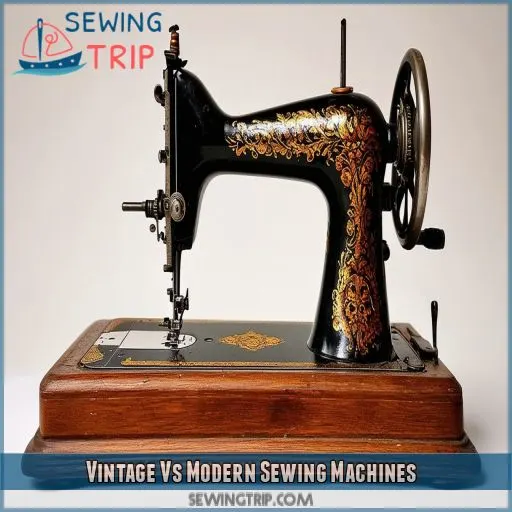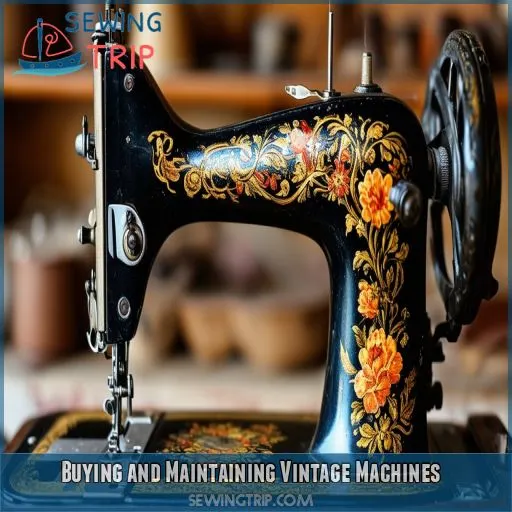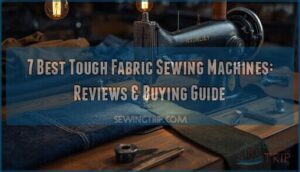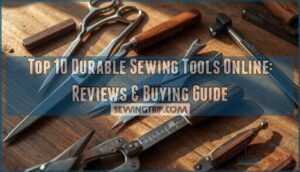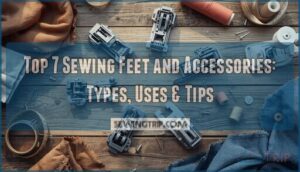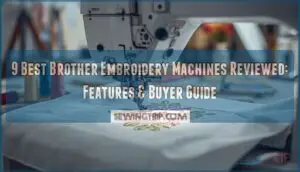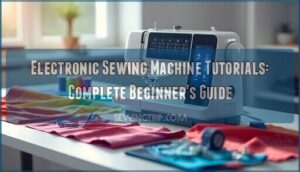This site is supported by our readers. We may earn a commission, at no cost to you, if you purchase through links.
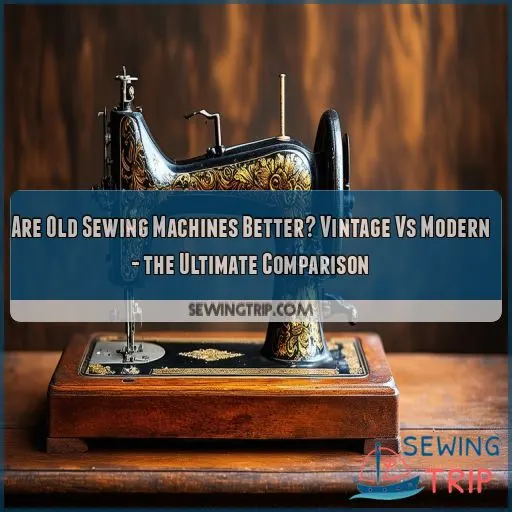
Plus, they offer exceptional value—lower upfront costs and cheaper repairs make them a smart investment. Not to mention, their timeless charm can add a unique touch to your sewing space.
However, modern machines come with sleek interfaces and more color options.
Curious about where to find these vintage gems and how to maintain them? You’re on the right track!
Table Of Contents
Key Takeaways
- Vintage sewing machines are built tough, lasting a lifetime with proper care, while modern machines may need replacing sooner.
- Old sewing machines offer superior stitch quality, especially for straight-stitch tasks like heirloom quilting.
- Vintage machines are often more affordable and easier to repair than modern ones, making them a smart investment.
- Old sewing machines have a timeless charm and can add a unique touch to your sewing space, while modern machines offer sleek interfaces and more color options.
Are Old Sewing Machines Better Than New Ones?
Yes, old sewing machines are often considered better than new ones because they’re more durable and provide higher quality straight stitches (Source). However, new machines offer more advanced features and are easier to use for beginners (Source).
Vintage Vs Modern Sewing Machines
When comparing vintage and modern sewing machines, you’ll find significant differences in durability, stitch quality, cost, and aesthetic appeal. Understanding these contrasts will help you make an informed decision about which type of machine best suits your needs and preferences.
Durability and Lifespan
Regarding durability and lifespan, vintage sewing machines overshadow their modern counterparts. Their metal parts make them sturdy, reliable, and long-lasting.
- They’re built to last a lifetime with fewer repair costs.
- Their environmental impact is lower due to repairability.
- Modern machines, with plastic parts, can break down sooner, impacting your long-term investment.
Stitch Quality and Performance
Regarding stitch quality and performance, vintage sewing machines truly excel. They offer:
- Consistent and precise stitches due to their superior feeding mechanisms.
- Effortless sewing experience thanks to sturdy metal components.
- Reduced skipped stitches and errors compared to weaker, plastic parts in modern machines.
Vintage machines deliver exceptional performance, particularly for straight-stitch tasks.
Cost and Value
When considering cost and value, vintage sewing machines often come out on top. You’ll find these older models offer exceptional value for money, combining affordability with longevity. Modern machines might seem appealing, but they can’t match the repairability and environmental consciousness of their vintage counterparts.
- Lower upfront costs for quality craftsmanship
- Longer lifespan reduces long-term expenses
- Easier and cheaper to repair
- Better return on investment due to durability
Aesthetics and Collectability
You’ll find that vintage sewing machines often boast timeless charm and collectible value. Their unique designs and sturdy craftsmanship make them appealing for both use and display. While modern machines offer sleek interfaces and color options, they can’t match the nostalgia of vintage style. Consider these points:
- Vintage machines are often prized for heirloom quilting and traditional piecing
- Old sewing machines can become valuable collectibles over time
- Art quilting enthusiasts appreciate the character of vintage machines
Buying and Maintaining Vintage Machines
If you’re considering buying a vintage sewing machine, you’ll need to know where to find them and what to look for. Once you’ve got your hands on one, understanding how to service and care for it will guarantee it continues to perform well for years to come.
Where to Find Vintage Machines
Now that you’re convinced of the merits of vintage sewing machines, let’s explore where to find these hidden gems. You’ve got several options to uncover these mechanical marvels:
- Rummage through dusty attics at local garage sales
- Scour online marketplaces like eBay or Etsy for rare finds
- Network with fellow sewists to snag family heirlooms
- Visit antique shops or flea markets for unexpected treasures
- Consult sewing machine repair shops for restored beauties
These avenues offer a mix of affordability, restoration potential, and functionality.
What to Look for When Buying
When buying a vintage sewing machine, you’ll want to focus on key factors to guarantee you’re getting a quality piece. Here are three essential things to look for:
- Condition assessment: Check for smooth operation of all moving parts.
- Attachments availability: Confirm essential accessories are included or obtainable.
- Brand reputation: Consider well-known brands like Singer for easier parts compatibility.
Don’t forget to review the sewing machine manual and explore troubleshooting resources before making your purchase.
Servicing and Care
To keep your vintage sewing machine in top shape, regular maintenance is key. Clean it thoroughly with a vacuum, duster, and gentle solution. For professional care, consider a sewing machine service package. When troubleshooting issues, consult online resources or local repair shops. Don’t forget to check attachment compatibility and explore restoration techniques to breathe new life into your machine.
- Embrace the satisfying click of a well-oiled vintage machine.
- Feel the pride of preserving a piece of sewing history.
- Experience the freedom of fixing issues yourself.
Frequently Asked Questions (FAQs)
Is it worth buying an old sewing machine?
You’ll find old sewing machines are often worth buying. They’re durable, reliable, and can last a lifetime with proper care. You’ll get high-quality stitching and the satisfaction of using a piece of history. Plus, they’re usually more affordable.
What is the difference between old and new sewing machines?
Old machines: sturdy metal workhorses. New ones: plastic marvels with bells and whistles. You’ll find durability and simplicity in vintage models, while modern machines offer convenience and advanced features. It’s a trade-off between timeless reliability and cutting-edge technology.
Is it better to fix an old sewing machine or buy a new one?
You’ll need to weigh the costs and benefits. Fixing an old machine can be cheaper and preserve its unique qualities. But if repairs are extensive, a new machine with modern features might be a better long-term investment.
What is the lifespan of a sewing machine?
Like a well-worn path, the lifespan of a sewing machine varies: vintage models can endure a lifetime with care, while modern machines typically last 5-10 years, depending on maintenance and usage.
Are Vintage sewing machines better than modern sewing machines?
Vintage sewing machines often outshine modern ones in durability and reliability. You’ll find they’re built to last, with sturdy metal parts and simpler mechanics. However, modern machines offer more features and convenience, so your choice depends on your specific needs.
Do you need a modern sewing machine?
You don’t necessarily need a modern sewing machine. It depends on your goals and preferences. Vintage machines excel at basic tasks, while modern ones offer advanced features. Consider your sewing needs, budget, and desired functionality before deciding.
What are the advantages of a modern sewing machine?
Did you know 90% of modern machines offer computerized features? You’ll enjoy automatic buttonholes, built-in stitches, and user-friendly interfaces. They’re lightweight, portable, and come with warranties. Plus, you’ll find abundant online tutorials for mastering your new machine.
How old are Vintage sewing machines?
Vintage sewing machines typically date back 30 to 100 years. You’ll find models from the early 20th century up to the 1980s. Their age can vary widely, but most prized vintage machines are from the 1950s-1970s era.
What is the Best Vintage sewing machine?
You can’t go wrong with a Singer 201 or 15- They’re powerhouses known for durability and smooth stitching. Look for models from the 1950s-60s in good condition. Don’t forget to think about a Featherweight for portability.
What are the pros and cons of sewing on a Vintage sewing machine?
You’ll enjoy the durability and timeless charm of vintage machines. They’re often more affordable and easier to repair. However, you might face challenges finding parts and accessories, and you’ll have fewer stitch options compared to modern models.
Can vintage machines handle modern fabrics like lycra?
Ever wondered if your vintage machine can handle modern stretchy fabrics? You’ll be pleased to know that many can, with the right needle and tension adjustments. They’re often sturdy enough to tackle lycra, giving you versatile sewing options.
How noisy are vintage sewing machines compared to modern ones?
You’ll find vintage machines are often louder than modern ones. They’ve got more metal parts clanking together, creating a distinctive rhythm. However, some sewers love this "industrial" sound, feeling it adds character to their crafting experience.
Are vintage machines suitable for quilting and embroidery projects?
You’ll find vintage machines can handle quilting and basic embroidery well. They excel at straight stitches, perfect for piecing quilts. For intricate embroidery, you might need attachments or consider a modern machine with built-in designs.
Do vintage machines require special needles or thread?
You’ll find that vintage machines typically work well with modern needles and thread. However, it’s wise to match the needle size to your fabric weight and use quality thread for the best results in your sewing projects.
Whats the energy consumption of vintage vs. modern machines?
You’ll find vintage machines sip energy like a dainty teacup, while modern ones gulp it down. Older models use less power, often running on 5-8 amps. Newer computerized machines can consume 0-5 amps, depending on features.
Conclusion
Did you know that vintage sewing machines can last over 100 years with proper care? While old sewing machines are often superior in durability and stitch quality, modern machines offer convenience and advanced features.
Ultimately, your choice hinges on your sewing needs and preferences. Whether you opt for a vintage gem or a sleek new model, remember that regular maintenance is crucial.

